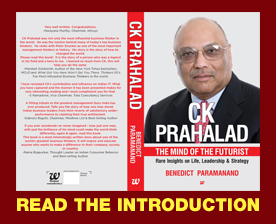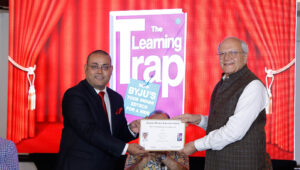Amish Tripathi is the author of The Shiva Trilogy, a mythologybased, three-book fiction series that has sold more than 1.7 million copies worldwide and earned Rs. 40 crore (US$7.40 million) so far.
Fellow writer Chetan Bhagat has several best-selling novels under his belt, including Five Point Someone — What Not to Do at IIT, which was made into a hit movie. The two men are alumni of the Indian Institutes of Management (IIMs) — Tripathi from Calcutta and Bhagat from Ahmedabad. Each began his career as a banker and spent several years in that profession before becoming authors. Both have become a “poster boy” for Indian publishing and the success that can be reaped in the sector. In past years, Indian fiction published in English didn’t stand a ghost of a chance in the domestic marketplace. Books typically sold a few thousand copies, most of them to readers living abroad. Today, however, authors of English-language fiction in India are increasingly finding broad readerships and pulling in solid sales numbers.
But the same has not been true for India’s business book market. Books written by IIM professors — including some of the same people who taught Tripathi and Bhagat — typically sell only a few thousand copies. Like in the fiction sector of the past, most of those books are sold abroad rather than domestically. IIMs are considered the top business schools in India; books by academics from lesser schools — India has more than 3,000 business schools — don’t sell even a few hundred copies. “We don’t make noise,” Shekhar Chaudhuri, former director of IIM Calcutta, told India Knowledge@Wharton for a past article.
The Fundamental Issue
Having the ability and resources to launch a high-decibel marketing campaign for a particular book is one issue. But is something more fundamental at work? “Let us ask a simple question.” says Vijay Govindarajan, professor of international business at the Tuck School of Business at Dartmouth College. “The three premier Indian management schools — the IIMs at Ahmedabad, Bangalore, and Calcutta — have been around for 50 years. The other premier business school — the Indian School of Business (ISB) — is over a decade old. Can these schools point to one management idea that they have pioneered that is taught in the top 10 business schools in the U.S.? I rest my case.”
Govindarajan is author of the 2012 book, Reverse Innovation: Create Far from Home, Win Everywhere, which made it to the New York Times and Wall Street Journal bestseller lists. “I have eight case studies of which six are based on Indian companies,” notes Govindarajan. “Why couldn’t a professor from the IIMs or ISB have created the ‘reverse innovation’ concept? After all, they are closer to the research sites.”
Govindarajan is quick to clarify, however, that the professors are not principally to blame. “There is a lack of research culture,” he says. “It is not about lack of capability.” According to Harish Bijoor, brand strategist and CEO of Harish Bijoor Consults Inc., in India, “teaching overtakes research…. Poorly written Indian cases are to blame as well.” Books, too, are often of doubtful merit. “There are good ones and there are bad ones. The pity is that in sheer volume terms, the badly written ones dominate the well-written ones,” Bijoor says.
The atmosphere can be corruptive. Visiting faculty at top Indian schools arrive from the West with books and research papers already under their belts and end up writing corporate hagiographies. The authors get full access to the company and produce laudatory texts. It’s a win-win situation except for the discerning reader.
Moving Beyond Textbooks
This is the type of book that often racks up robust sales figures; the company being profiled will buy most of the copies to distribute as corporate gifts. Another category that sells relatively well is the business school textbook. “Indian professors in India have traditionally written textbooks rather than books targeted at a managerial audience,” notes Rishikesha T. Krishnan, professor of corporate strategy and policy at IIM Bangalore, and author of From Jugaad to Systematic Innovation: The Challenge for India, which topped business bestseller lists in India.
“Even the good Indian B-schools are actually teaching schools,” adds Jayanta Nath Mukhopadhyay, dean of the global campus of Globsyn Business School. “The faculty in India gets little time for research and writing an original book with serious analysis.” Instead, they pen textbooks — a more elaborate version of the curriculum they are teaching in the classrooms. Mukhopadhyay points out that there have been some excellent textbooks released in the area of finance. But the books typically deal with the nitty-gritty — analysis and application of the laws prevailing in India. Because accounting standards and procedures differ from country to country, these books are largely irrelevant to audiences outside India.
Textbooks may add to the reputation of a professor within the student community. But it doesn’t take him or her places among practicing managers. And even if an academic writes a book that appeals to managers in India, how far will it travel? Krishnan says he is more interested in writing about India and Indian companies. “But that perspective may not have a global market,” he adds.
Relevant Strategies
Ravi Aron, professor at the Johns Hopkins Carey Business School and senior fellow of the Mack Institute for Innovation Management at Wharton, notes that Krishnan’s chosen topic of jugaad is a doubtful candidate for global relevance. Jugaad is defined as low-cost, improvised innovation — making do with what you have.
“Foreign business books describe strategies in business environments that most countries aspire to,” says Aron. “A reader in Malaysia, Brazil, Russia or South Africa eventually wants his country’s business environment and businesses to resemble those of the developed Western economies. If you try to plug jugaad or dabbawallahs [a system of delivering lunches to offices], [the reader] might have some passing interest in what he [or she] might see as a charming quirk in a chaotic region.” Indeed, Krishnan in his recent books has acknowledged that jugaad is no longer enough in a globalized world.
Aron offers some additional reasons why Indian business books don’t work: “The world loves to read about successful entities, swathed in easily visible glamour — Apple, Google, Goldman Sachs — or about figures that stride on a world stage — Branson, Jobs, Gates, Blankfein,” he notes. “A business book reader in Eastern Europe or Thailand may want to read about what’s happening in his ‘aspirational business ecosystem’ — and India is not in that ecosystem.”
He adds that Indian business books about Indian businesses typically describe idiosyncratic conditions that apply only to India, which is not very useful as learning material for conducting business in developed economies. Most of the problems of doing business in India have to do with doing business “in spite of India,” Aron notes.
“It is not about overcoming competition or functioning in reasonably transparent markets. It has to do with doing business in a make-believe world created by a peculiar confluence of forces in India,” he says. “There are companies such as Reliance that have mastered playing the Indian state’s game. But what can BP or Royal Dutch Shell learn from Reliance? If Hindustan Unilever finds innovative ways of delivering tea packets and detergents in Northeastern India in spite of the poor surface transport, what can Johnson & Johnson or Procter & Gamble from this, other than for their businesses in India?” learn
Getting a Worldview
When the Indian professor goes abroad, he or she acquires an expanded worldview. “The Indian authors outside India are more in tune with what managers, both in and out of India, want to read about Indian business,” says Nirmalya Kumar, professor of marketing and director of the Aditya Birla India Centre at London Business School. “Being outside India gives these foreign-based professors a global view, access to global companies and the ability to see what is unique about Indian business best practices. Unfortunately, Indian business school professors do not have the same access to companies, even Indian ones, as do the famous Indianorigin professors. The limited access to the inside workings of the firms make the books less interesting.”
Krishnan notes that part of the blame must rest with the publishers. “Most publishers in India are either local, or appear to be cut off from their international counterparts. They don’t have a world market in mind,” he notes. “There is inadequate editorial support to fashion a book for the global market.”
According to Poornima Swaminathan, commissioning editor at Jaico Publishing House, books written by business school professors of Indian origin based in the U.S. “have a better chance of becoming bestsellers as, apart from being academicians, these authors also work as consultants in multinational corporations,” she says. “This helps them approach writing the book and promoting it in a completely different fashion.” Even at the IIMs, consultancy assignments from industry are few and far between in India.
Swaminathan adds that Indian publishers have been found wanting in one respect — marketing. “In terms of aggressive marketing, Indian publishers have a long way to go,” she notes. “The publisher, along with the author, needs to have a vision to ensure the book sells in huge numbers. That said, the publishing space in India is definitely undergoing a positive change.”
There is more marketing of Western business books in India than there is of the local offerings. Tripathi says Shiva Trilogy’s success was at least 50% due to marketing. He points out several books that would have done better had they been sold properly. But professors in India don’t even like to talk about marketing; they think their books should sell on merit. “That, too, is changing,” Swaminathan notes. Adds Bijoor: “They do believe in marketing in the West. But it is not marketing alone that makes the books successful.”
Change Is in the Air
Opinions about the importance of marketing are not the only thing that is changing in the sector. “We are seeing more interest in writing books for managers,” says Krishnan. “For example, IIM Ahmedabad now has an agreement with Random House to write a series of such books. IIM Bangalore has recently tied up with Pearson.”
Kumaar Bagrodia is CEO of LeapVault, an executive development and knowledge media organization that is establishing India’s first non-fiction books conference soon. He, too, feels that things are changing. “Indian consumers have had to generally look toward Western markets to understand and imbibe modern business practices,” Bagrodia notes. “That is now changing: In the past decade or so, with the story around business models and practices in the West turning out to be not all that rosy, coupled with the emergence of successful world-class companies in India, there is significant domestic demand and global interest for such content from India. And, yes, the marketing of these books is not strong in India as authors have not had opportunities for monetizing their efforts in terms of speaking and consulting fees. This, too, is changing, albeit to a lesser degree.” Change won’t happen overnight, however. “The knowledge sun rises in the West and sets in the East,” says Bijoor. “This is a thought that has been perpetuated continuously in Indian school, college and business school education. This will take some to change.”
Aron has a more fundamental question. “Is reading being replaced by cognitively less demanding pursuits — TV, social media, video games, YouTube?” he asks. If so, it’s a bleak future for all academic authors; they must learn to master new media to communicate their ideas.
For the moment, however, Aron has a suggestion for those writers: “A different kind of an Indian business book — not necessarily aimed at the business executive and certainly not a ‘guru’ book — might work better,” he says. “That book would describe India, some of its history, catalog some social forces and discuss how they shaped business and society in India. It would be generalinterest reading set deep in an economic milieu. It would be a sort of travel through the Indian economy trawling for stories and is meant to appeal to general readers who want intelligently-observed descriptions of the life and times of a place.”












Recent Comments